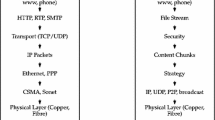Abstract
In this paper, we propose a Content-Oriented Framework for future Internet (COFI) to reduce content-oriented communication costs and latency by exploiting advantages of IP networks and CCN. To be compatible with the Internet, COFI maps a name prefix to a global routing prefix and a name to an anycast address. In this way, a content-centric domain identified by a name prefix can also be defined by the mapping global routing prefix, and the content identified by a name can also be specified by the mapping anycast address. Based on the mapping mechanism, the content-oriented communications between IP and CCN are achieved in the unicast way. Moreover, COFI proposes the request pending mechanism so that multiple consumers share desired contents via one communication process. COFI is evaluated, and the data show that COFI reduces content-oriented communication costs and latency.






Similar content being viewed by others
References
Habibzadeh, H., Dinesh, K., Shishvan, O. R., Boggio-Dandry, A., Sharma, G., & Soyata, T. (2020). A survey of healthcare internet of things (hiot): A clinical perspective. IEEE Internet of Things Journal, 7(1), 53–71
Wang, X., & Cai, S. (2020). Secure healthcare monitoring framework integrating ndn-based iot with edge cloud. Future Generation Computer Systems, 112, 320–329
Wang, X., & Cai, S. (2020). An efficient named-data-networking-based iot cloud framework. IEEE Internet of Things Journal, 7(4), 3453–3461
Cisco, . (2014). Cisco visual networking index: Forecast and methodology: 2013–2018. San Jose, CA, USA, Tech: Rep.
Wang, X. (2015). IPv6-Based vehicular cloud networking. IEEE Communications Letters, 19(6), 933–936
Dhingra, S., Madda, R. B., Gandomi, A. H., Patan, R., & Daneshmand, M. (2019). Internet of things mobile - air pollution monitoring system (iot-mobair). IEEE Internet of Things Journal, 6(3), 5577–5584
Wang, X. , & Lu, Y. . (2020).Efficient forwarding and data acquisition in NDN-based MANET. IEEE Transactions on Mobile Computing.
LeeLeeGerlaOh, V. E. K. Y. M. S. Y. (2014). Vehicular cloud networking: Architecture and design principles. Communications Magazine, IEEE, 52(2), 148–155
Arshad, S., Azam, M. A., Rehmani, M. H., & Loo, J. (2019). Recent advances in information-centric networking-based internet of things (ICN-IoT). IEEE Internet of Things Journal, 6(2), 2128–2158
Jacobson, V., Smetters, D. K., Thornton, J. D., Plass, M. F., Briggs, N. H., & Braynard, R. L. (2012). Networking named content. Communications of the acm., 55(1), 117–124
Kamel, G., Wang, N., Vassilakis, V., Sun, Z., Navaratnam, P., Wang, C., & Tafazolli, R. (2015). CAINE: a context-aware information-centric network ecosystem. IEEE Communications Magazine, 53(8), 176–183
Wang, X., & Zhu, X. (2017). Anycast-Based Content-Centric MANET. IEEE Systems Journal, 12(2), 1679–1687
Hinden R M, Deering S E (2006). IP version 6 addressing architecture. IETF RFC 4291.
Gladisch, A., Daher, R., & Tavangarian, D. (2014). Survey on mobility and multihoming in future internet. Wireless personal communications, 74(1), 45–81
McPherson, D., Oran, D., Thaler, D., & Osterweil, E. (2014). Architectural considerations of IP anycast. RFC 7094.
Kostin, A. E., Fanaeian, Y., & Al-Wattar, H. (2016). Anycast tree-based routing in mobile wireless sensor networks with multiple sinks. Wireless Networks, 22(2), 579–598
Gao, D., Lin, H., & Liu, X. (2016). Routing protocol for k-anycast communication in rechargeable wireless sensor networks. Computer Standards & Interfaces, 43, 12–20
Kim, J., Lin, X., Shroff, N. B., & Sinha, P. (2010). Minimizing delay and maximizing lifetime for wireless sensor networks with anycast. IEEE/ACM Transactions on Networking, 18(2), 515–528
Wang, X. (2008). Analysis and design of a k-Anycast communication model in IPv6. Computer Communications, 31(10), 2071–2077
Fang, C., Yao, H., Wang, Z., Wu, W., Jin, X., & Yu, F. R. (2018). A survey of mobile information-centric networking: research issues and challenges. IEEE Communications Surveys & Tutorials, 20(3), 2353–2371
Khelifi, H., Luo, S., Nour, B., Moungla, H., Faheem, Y., Hussain, R., et al. (2020). Named data networking in vehicular ad hoc networks: State-of-the-art and challenges. IEEE Communications Surveys & Tutorials, 22(1), 320–351
Tsilopoulos, C., & Xylomenos, G. (2011). Supporting diverse traffic types in information centric networks. In Proceedings of the ACM SIGCOMM workshop on Information-centric networking (pp. 13–18). ACM.
Gupta, A., & Shankarananda, B. M. (2015). Fast interest recovery in content centric networking under lossy environment. In 2015 IEEE CCNC, IEEE (pp. 802–807).
Wang, L., Waltari, O., & Kangasharju, J. (2013). Mobiccn: Mobility support with greedy routing in content-centric networks. In 2013 IEEE Global Communications Conference (GLOBECOM) (pp. 2069–2075). IEEE.
Amadeo, M., Molinaro, A., & Ruggeri, G. (2013). E-CHANET: Routing, forwarding and transport in information-centric multihop wireless networks. Computer Communications, 36(7), 792–803
Wang, D., & Wang, X. (2021). Content-centric framework over the internet environments. Wireless Personal Communications, 116(3), 2135–2158
Wang, X., Wang, X., & Li, Y. (2021). Ndn-based iot with edge computing. Future Generation Computer Systems, 115, 397–405
Acknowledgement
This work is supported by National Natural Science Foundation of China (61202440).
Author information
Authors and Affiliations
Corresponding author
Additional information
Publisher's Note
Springer Nature remains neutral with regard to jurisdictional claims in published maps and institutional affiliations.
Rights and permissions
About this article
Cite this article
Li, Y., Wang, X. Content-oriented Framework for Future Internet. Wireless Pers Commun 120, 869–886 (2021). https://doi.org/10.1007/s11277-021-08494-0
Accepted:
Published:
Issue Date:
DOI: https://doi.org/10.1007/s11277-021-08494-0




